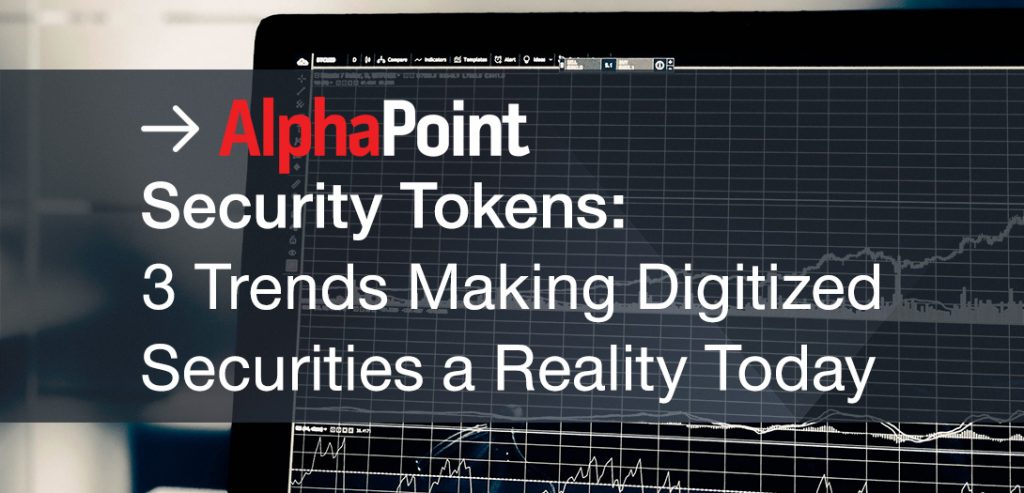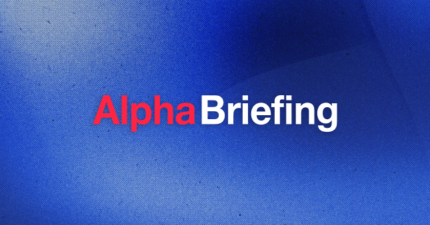Security Tokens: 3 Trends Making Digitized Securities a Reality Today

In our previous post, we outlined the benefits of digitizing traditional asset classes through tokenization on a blockchain. In today’s post, we’ll address the question, “Why now? Is the market ready for digital securities?”
Security Token Offerings – Progress to date
As of April 2019, most of the security tokens created are for equity in illiquid assets such as private equity funds, real estate, art, or private company shares. A majority of these security token offerings have issued shares on a blockchain-based system but have not yet enabled these shares to trade on a liquid secondary market. For example, OpenFinance, the first regulated U.S. security token trading platform, offers just two security tokens as of this writing1.
Blockchain-enabled digital securities are powerful because they combine:
- Programmable digital assets, (through the use of smart contracts) which enable automated compliance and executable business logic
- Monetary payment rails on the same system as the digital asset, which creates settlement efficiency
- A clear, immutable ledger of information that provides transparency into the underlying asset, valuation, and transactions
The technology to create tokenized securities is just one component of the infrastructure required to realize the benefits of asset digitization for capital markets and financial ecosystems. Following are 3 components that we’ve identified as critical to making the new world of digital securities a reality:
- Custody
Institutional-grade custody solutions that are equipped to store and manage digital assets across a variety of blockchains are required in order to comply with securities regulations. These solutions must be registered as qualified custodians in order to hold digital securities on behalf of clients, and they must offer appropriate access controls and investor safeguards. - Blockchain Based Payment Options
In order to take advantage of the settlement efficiencies, reduced counterparty risk, and automated distributions on a blockchain system, investors must be able to access a reliable on-chain payment option. Typically, this has been achieved through cryptocurrencies, however, “stablecoins” (crypto assets that are pegged to fiat currency or hard asset) are a potential alternative given the exchange rate risk of cryptocurrencies. - Secondary Markets
The promise of digital securities is realized when there is a liquid secondary market for tokenized assets to trade, thereby reducing the illiquidity discount typically associated with assets such as real estate. Registered and compliant exchanges that have the infrastructure to list digital securities and provide standardized data are emerging.
Recent trends indicate that solutions for custody, blockchain-based payment options, and secondary trading can support a viable ecosystem for digital securities.
Custody
Just a few years ago, the majority of the digital asset custody products were focused on retail cryptocurrency traders. These solutions placed the responsibility of managing assets on the end user. While that approach was sufficient for unregulated products, digital securities require a qualified custodian to manage assets on behalf of clients. Moreover, custody solutions must enable enterprise restrictions such as multi-party access, spending limits, multiple approvals, and minimum spend thresholds.
Custody solutions have evolved that can support security tokens:
- Custody solutions such as BitGo and PrimeTrust are popular options for security tokens
- The announcement of Fidelity’s planned launch of custodial services is a step in the right direction. As the 4th largest asset manager in the world, Fidelity is well equipped to provide the requisite security and compliance for digital assets.
What’s next?
As the digital securities market grows, we’ll see a proliferation of enterprise-grade custody solutions and qualified custodians that can facilitate the new digital security infrastructure.
Custody Solutions in action:
AlphaPoint offers hot wallet software solutions that integrate with all prominent custody solutions, enabling custodians to store and manage digital assets on behalf of clients.
Blockchain Based Payment Options
One of the most promising drivers of the adoption of tokenized securities is the ability to enable near-instant settlement times by transacting on blockchain-based systems. The operational efficiency improvements free up capital from back-office expenses for higher impact investments.
However, when investors use fiat currencies to purchase or trade security tokens, these efficiencies are lost. Integration with traditional banking and payments infrastructure increases settlement time to T+2 or T+3, and do not allow for automated distributions or reduced counterparty risk.
Cryptocurrencies leverage the efficiency and settlement time of a blockchain platform. However, the volatility associated with traditional cryptocurrencies such as Bitcoin or Ether makes it unsuitable for purchasing security tokens, which are typically intended as long-term investments.
Blockchain-based payment options have evolved to enable near-instantaneous settlement without the exchange rate risk:
- Stablecoins are digital assets that are collateralized with physical assets, financial assets, or other currencies (either cryptocurrency or fiat currency). They are designed to be stable in value and are often pegged 1:1 with a fiat currency, therefore, they have the price volatility of traditional currency markets.
- An example of this is Circle’s USDC or Maker’s DAI
- JP Morgan recently entered this space with the creation of JPM Coin, which is designed to match the value of the US Dollar. With the JPM Coin, institutional clients can instantaneously transfer payments between accounts.
What’s next?
Beyond other banks creating more stablecoins, over time we’ll see central banks emerge with their own digital currencies on blockchain-based systems. Governments around the world are already beginning to pilot the technology, providing more tailwind behind digital security market growth.
Secondary Markets
Regulated exchanges for security tokens are another requirement in order to realize the promise of additional liquidity on a blockchain-based system. Before an exchange can list security tokens, it must be registered in the appropriate jurisdiction(s) and must be equipped to perform adequate Know Your Customer (KYC) and Anti-Money-Laundering (AML) verifications on investors.
New exchanges, including those launched to trade cryptocurrencies or ICOs, therefore must complete a time-consuming filing process before offering liquidity for digital assets.
Meanwhile, licensed public and private exchanges that already enable trading and provide liquidity for traditional securities may not have the technology infrastructure required to list and trade security tokens.
Recently, secondary markets have emerged that are registered for security tokens and have the requisite technology and compliance infrastructure. As an example, NYSE parent company (Intercontinental Exchange, aka ICE) created BAKKT to enable consumers and institutions to purchase and trade digital assets.
What’s next?
As the number, volume, and market capitalization of securities issued on blockchain-based systems continue to grow, the incentive to provide compliant secondary marketplaces for trading and providing liquidity for digital security tokens will increase as well.
Secondary marketplaces are already emerging, with AlphaPoint technology clients such as Muirfield and Laureate Digital Securities issuing asset-backed security tokens and providing liquidity via private and public exchanges.
At AlphaPoint, we’re excited for the growth of the digital securities ecosystem. The infrastructure required to unleash the potential of blockchain technology for capital markets continues to evolve, and forward-thinking institutions can get ahead of the curve by creating digital securities for the next generation of investors.


